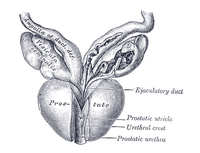
Photo from wikipedia
PurposeTo evaluate the predictive role of maternal urinary CA 19-9 as a non-invasive marker for diagnosing antenatal posterior urethral valve (PUV).MethodsA total of 40 women in the third pregnancy trimester… Click to show full abstract
PurposeTo evaluate the predictive role of maternal urinary CA 19-9 as a non-invasive marker for diagnosing antenatal posterior urethral valve (PUV).MethodsA total of 40 women in the third pregnancy trimester were enrolled. Case group (group A) consisted of 20 women with a diagnosis of antenatal PUV. Twenty women with similar gestational age, fetal sex, normal US, and no history of congenital anomalies were chosen as a control group (group B). Maternal urine samples were collected and urinary CA 19-9 was measured in both groups. The correlations between maternal urinary CA 19-9 and APD (measured during pregnancy and the initial evaluation of the newborn) were assessed. CA 19-9 level in first urine of neonates was also evaluated.ResultsThe mean ± SD of maternal urine CA 19-9 was higher in PUV group compared to the control group (131.6 ± 23.8 vs. 13 ± 2.7 U/mL). In addition, there was a significant correlation between maternal urinary CA 19-9 and the APD measured at the third trimester (p < 0.001) and the initial evaluation of fetus after birth according to SFU grading system (p < 0.001). However, no significant difference was found between gestational age and urinary CA 19-9 level (p = 0.34). There was also a significant correlation between the CA 19-9 level in first urine of neonates and CA 19-9 level of maternal urine (p < 0.001).ConclusionsThis is the first time that maternal urinary CA 19-9 has been applied as a noninvasive and practical diagnostic marker in antenatal PUV.
Journal Title: International Urology and Nephrology
Year Published: 2019
Link to full text (if available)
Share on Social Media: Sign Up to like & get
recommendations!